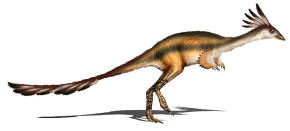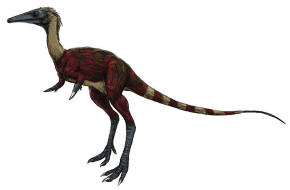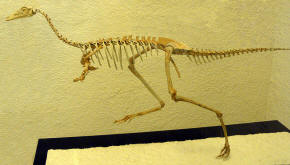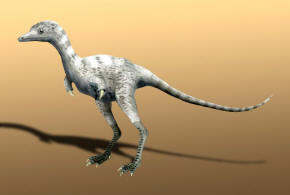Alvarezsaurus, and thus Alvarezsauroidea, Alvarezsauridae, and
Alvarezsauria are named for the
historian Don Gregorio Alvarez, not the more familiar
physicist
Luis Alvarez, who proposed that the
Cretaceous-Tertiary extinction event was caused by an
impact event.
Description
Alvarezsaurs range from 0.5–2 m (20–80 inches) in length, although some
possible members may have been substantially larger, including the European
Heptasteornis
that may have reached 2.5 m (8 ft). Fossils attributed to alvarezsaurs have
been found in
North and South
America and Asia, and
range in age from the late
Jurassic to the late
Cretaceous periods, about 160 to 65 million years ago.
Feathers
At least one specimen of alvarezsaur, from the
species
Shuvuuia
deserti, preserved down-like,
feathery,
integumental structures covering the fossil. Schweitzer
et al.
(1999) subjected these filaments to microscopic, morphological, mass
spectrometric, and immunohistochemical studies and found that they consisted
of
beta-keratin,
which is the primary protein in
feathers.
History,
study and debate
Bonaparte (1991) described the first alvarezsaurid,
Alvarezsaurus calvoi, from an incomplete skeleton found in
Patagonia, Argentina. Bonaparte also erected a monotypic family to contain
it. He argued that it might be most closely related to the
Ornithomimosauria.
Perle et al. (1993) described the next alvarezsaur to be
discovered, naming it Mononychus olecranus (meaning “one claw”). A
month later they changed the genus name to
Mononykus, because
the earlier spelling was already the genus name of an extant butterfly.
Perle et al. (1993) mistakenly described
Mononykus as a
member of
Avialae, and
one more advanced than
Archaeopteryx.
They argued that the family Alvarezsauridae was actually a group of Mesozoic
flightless birds on the basis of derived features that were unique to birds.
Novas (1996) described another member of the class called
Patagonykus puertai.
Karhu and Rautian (1996) described a Mongolian member of the family;
Parvicursor remotus.
Chiappe et al.(1998) described another Mongolian member,
Shuvuuia mongoliensis
and mistakenly found it to be even more derived, concluding that the
alvarezsaurs were actually crown – group, or modern, birds.
These mistaken assignments of alvarezsaurs to birds were caused primarily
by features that are strikingly, or even uniquely, avian. The sternum, for
example, is elongated and deeply keeled for an enlarged pectoralis muscle,
as it is in
neognathous birds and
volant
ratites. One bone in the skull of
Shuvuuia appeared to
be an ectethmoid fused to a prefrontal. The ectethmoid is an ossification
known only in
Neornithes. Other birdlike characters included the palatine, foramen
magnum, cervical and caudal vertebrae, and many others.
Several researchers disagreed with Perle
et al. (1993) and Chiappe
et al. (1998). Feduccia (1994), Ostrom (1994), Wellnhofer (1994),
Kurochkin (1995), Zhou (1995), and Sereno (1997) considered it unlikely that
alvarezsaurids were members of
Avialae. Martin (1997)
performed a cladistic analysis but Sereno criticized it strongly, finding it
flawed by incorrect codings, use of only select data, and results that did
not support his conclusions. Sereno (1999) performed a new analysis,
revising the anatomical interpretations and clarifying the characters. He
found that alvarezsaurids were more parsimoniously related to the
Ornithomimosauria.
As the more primitive members of the Alvarezsauridae were better
characterized, the monophyly of the clade was strongly supported, but the
more primitive members lacked the most birdlike traits. Some of these traits
had been misinterpreted, also. The remaining similarities between birds and
alvarezsaurs, like the keeled sterna, are another case of
homoplasy; where the derived alvarezsaurids developed birdlike
characters through convergent evolution, rather than inheriting them from a
common ancestor with birds.
Select Species
|
Alvarezsaurus is a genus of small alvarezsaurid
dinosaur from the Late Cretaceous period of Argentina, approximately
86 - 83 million years ago. Estimates suggest that it measured about
2 meters in length and weighed approximately 20 kg. It was found in
the
Bajo de la Carpa Formation and was named by paleontologist José
Bonaparte in 1991 after the historian Don Gregorio Alvarez.
The type species is A. calvoi. It was bipedal, had a long
tail and its leg structure suggests that it was a fast runner. It
may have been insectivorous and was
basal to better-known members of its family, such as
Mononykus
and Shuvuuia.
It has been alternately classified with both non-avian
theropod dinosaurs and early
birds.
|

(Picture
Source) |
Shuvuuia is a
genus of bird-like
theropod dinosaur
from the late Cretaceous
period of Mongolia. It
is a member of the family Alvarezsauridae, small
coelurosaurian dinosaurs which are characterized by short but powerful
forelimbs specialized for digging. The type (and only known) species is
Shuvuuia deserti, or "desert bird". The name
Shuvuuia is derived
from the Mongolian word shuvuu (шувуу) meaning "bird".
(Picture
Source)
|
 |
|
Mononykus (meaning "one claw") was a theropod
dinosaur from late Cretaceous Mongolia (Nemegt
Formation, about 70 million years ago) with long, skinny legs.
It moved about on two legs, was very nimble, and could run at high
speeds, something that would have been useful in the open desert
plains where it lived. It had a small skull, and its teeth were
small and pointed, suggesting that it ate insects and small animals,
such as lizards and mammals. Large eyes allowed Mononykus to
hunt by night, when it was cooler and there would have been fewer
predators about. Mononykus was originally named
Mononychus in 1993, but later that year, it was renamed
because the original name had already been used for a
beetle named by
Johann Schueppel, a German
entomologist.
Mononykus was a small dinosaur, only 1 metre (3.3 ft)
long. Other characteristics include fused
wrist bones similar
to those of birds, and a keeled breastbone. It differed from close
relatives
Shuvuuia and
Parvicursor
in several details of its skeleton, including a pubic bone that is
triangular in cross section, and different proportions in the toe
bones.
|

Reconstructed skeleton of Mononykus (Picture
Source) |



